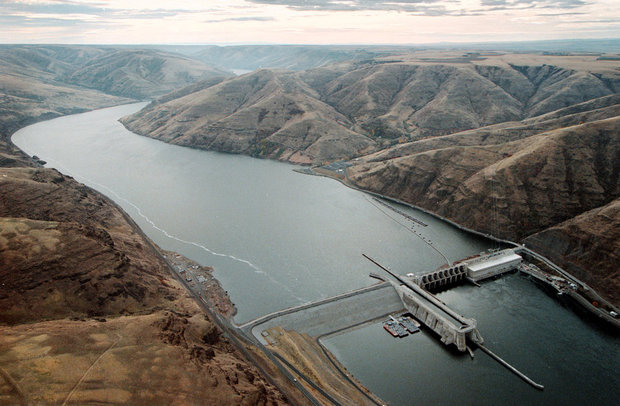forum
library
tutorial
contact

Experts Debate Dam Removal
by Jessica ZhouDaily Evergreen, March 29, 2017
|
the film forum library tutorial contact |

|
Experts Debate Dam Removalby Jessica ZhouDaily Evergreen, March 29, 2017 |
Advocates for and against Snake River dams discuss pros and cons of taking them out
 A panel of experts on both sides of the issue argued Tuesday over whether to get rid of the dams located on the Snake River, a long-standing and controversial argument that turns primarily on the dams' harm to salmon populations and importance to the regional economy.
A panel of experts on both sides of the issue argued Tuesday over whether to get rid of the dams located on the Snake River, a long-standing and controversial argument that turns primarily on the dams' harm to salmon populations and importance to the regional economy.
Sophia Steele, president of the WSU chapter of the WPCYP, introduced the panelists and the respective sides of the debate.
"The four lower Snake River dams were built to provide navigation. It also provides transportation for exports, low-cost carbon free energy, flood control, and recreational activities," she said.
Conversely, reservoirs behind the dams allow the water to warm, which can harm or kill salmon, a coldwater fish.
Everyone wants to make sure salmon runs are strong because they help the Puget Sound, said Todd Myers, director of the Washington Policy Center's Center for the Environment and member of the Puget Sound Salmon Recovery Council. But Myers also pointed out the importance of carefully weighing the tradeoffs of dismantling the dams.
In the state's Department of Natural Resources, he recalled an instance in which his team mistakenly thought destroying timber communities would bring back the spotted owl, which it did not.
"We paid a very high price because we thought this would help," Myers said. "We are now to the point where we are shooting barn owls. That is what happens when you make environment policies on hopes and not science."
He said the dams make up as much as eight percent of carbon-free electricity, which would be expensive to replace with wind or natural gases.
"The reason that wind turbines work is because you have the dams - the electricity that balanced that out is hydroelectric," Myers said. "If you don't have the battery [dam] to offset wind, you lose the capacity for wind."
Sam Mace, outreach director of Save Our Wild Salmon, said the four dams discussed make up four percent of the region's power, and the most significant energy contributions occur during the spring.
"In the spring," Mace said, "the grid often can't handle it, the wind farm will often shut down."
In 2015, 99 percent of the Idaho sockeye run perished due to the dams, she said, which is indicative of the harm done to the state's' wild salmon.
She also said the dams built from 1960 to 1975 were controversial and a waste, given the failed effort to create a thriving local economy of "boondoggle" Lewiston, which was intended to be a seaport.
"These four dams do not provide flood control, do not hold water," Mace said.
Kevin Lewis, executive director of Idaho Rivers United, said Washington had an excess of energy, and that it exported its energy to states like California.
U.S. District Court Judge Michael Simon invalidated the most recent biological opinion governing operations of the dams regarding salmon and steelhead, Steele said. Some applaud the judge's ruling to support salmon and steelhead whereas others are concerned with the harm to the economy and possible detriment to efforts to address climate change.
Doc Hastings (R), former Congressman of the 4th District, feared Simon may be an "activist judge," by unjustly legislating from the fence. He said there was no reason for the dams to be torn down because fish runs were at healthy numbers.
Judge Simon ordered a new analysis ordering major overhaul of management of the dams, with the possibility of tearing down the dams. The new analysis will be delivered no later than March 2018.
learn more on topics covered in the film
see the video
read the script
learn the songs
discussion forum
